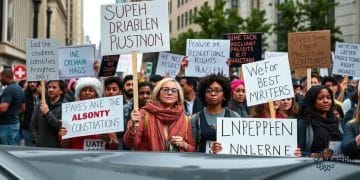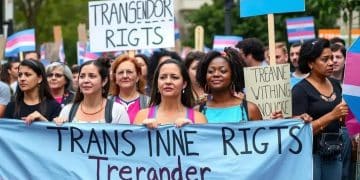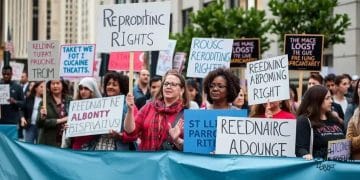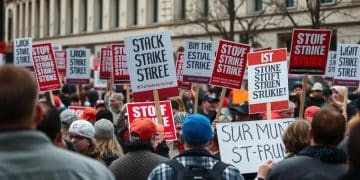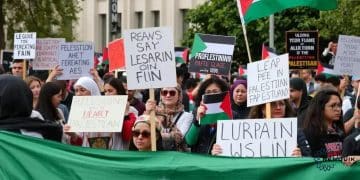Immigration policy demonstrations: what you need to know
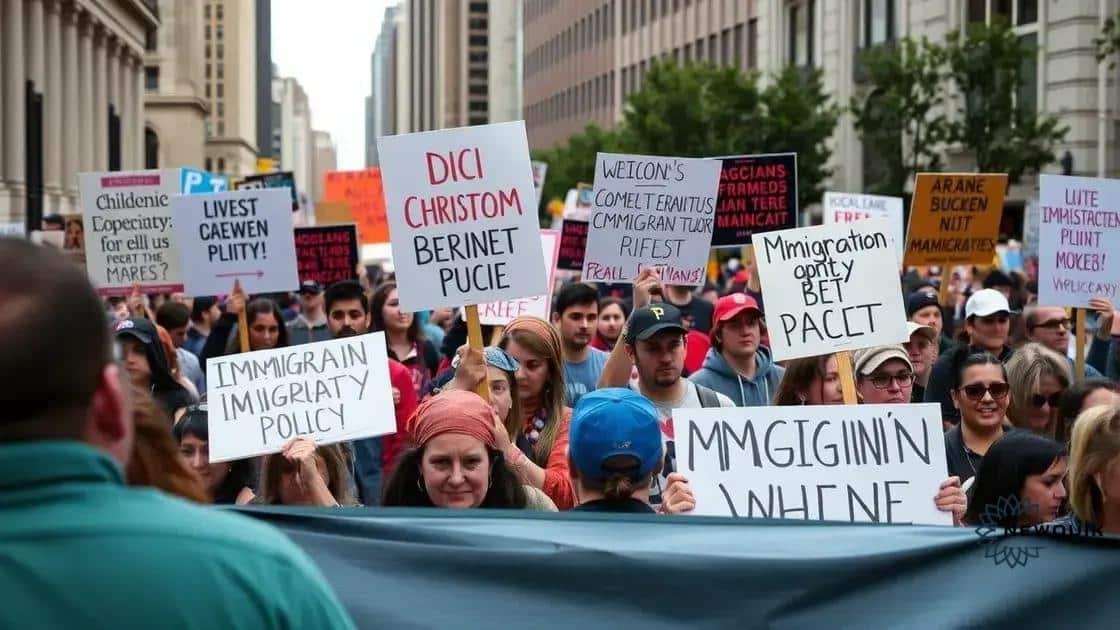
Immigration policy demonstrations are public protests advocating for reform and raising awareness about the challenges faced by immigrants, often focusing on issues like family separation and human rights.
Immigration policy demonstrations are more than just rallies; they’re a reflection of people’s hopes and frustrations. If you’ve noticed the rise in such events lately, you might wonder what truly drives this fervor. Let’s dig deeper into the reasons behind these demonstrations and their significance.
Understanding immigration policy
Understanding immigration policy is crucial to grasp how it affects individuals, communities, and nations. This complex topic encompasses various laws, regulations, and practices that dictate who can enter and remain in a country.
Immigration policy can vary greatly from one nation to another, reflecting each country’s values and priorities. In many cases, these laws are shaped by historical events, economic demands, and social beliefs.
Key Elements of Immigration Policy
Different countries have unique elements within their immigration policies. These aspects can include:
- Eligibility criteria: Requirements that determine who can apply for residency or citizenship.
- Visa types: Different categories of visas, such as work, student, or tourist visas.
- Enforcement mechanisms: Measures taken to ensure compliance with immigration laws.
- Paths to citizenship: Processes by which immigrants may become citizens of the country.
The emotional and social aspects of immigration policy are equally important. Many families and individuals face challenges due to strict regulations or sudden changes in the law. Stories of struggle can shine a light on the human impact of these policies.
The Role of Public Opinion
Public opinion plays a significant role in shaping immigration policy as well. Advocacy groups often rally citizens to support reform or oppose specific measures. These movements can influence lawmakers, showcasing the power of collective voices.
Understanding immigration policy requires looking beyond the laws themselves. It’s about grasping the larger context and recognizing how policies affect real lives. In many cases, this understanding can foster empathy and drive change.
Key reasons for protests
The key reasons for protests surrounding immigration policy often stem from the personal experiences and struggles of individuals and communities. Many people feel that current policies fail to protect human rights or meet the needs of diverse populations.
Protests serve as a platform for voices that are often unheard. They highlight the frustrations related to issues like family separation, deportations, and barriers to citizenship. These factors contribute to a sense of urgency among activists who advocate for more compassionate policies.
Importance of Family Unity
One of the most significant reasons for demonstrations is the desire to preserve family unity. Many families are torn apart due to strict immigration laws. This creates emotional distress and instability for the family members involved.
- Emotional impact: Family separation can lead to mental health issues.
- Children’s well-being: Kids often suffer when their parents are deported.
- Community stability: Strong families lead to healthier communities.
The struggle for immigration rights also reflects broader societal values about inclusivity and diversity. Activists argue that welcoming immigrants benefits society as a whole. This belief often drives the passion behind protests, as individuals come together to promote change.
Economic Disparities
Economic issues also play a crucial role in motivating protests. Many advocate for fair labor practices and equal opportunities for all workers. Concerns about exploitation and unfair treatment are frequent rallying points.
People believe that a just immigration system should support those contributing to the economy. This perspective highlights the need for reform to address these disparities.
As we delve into the key reasons for protests, it becomes clear that the fight for equitable immigration policy is multifaceted. Advocates are united by a shared vision of a society that supports families, respects human dignity, and promotes economic fairness.
Historical context of immigration demonstrations
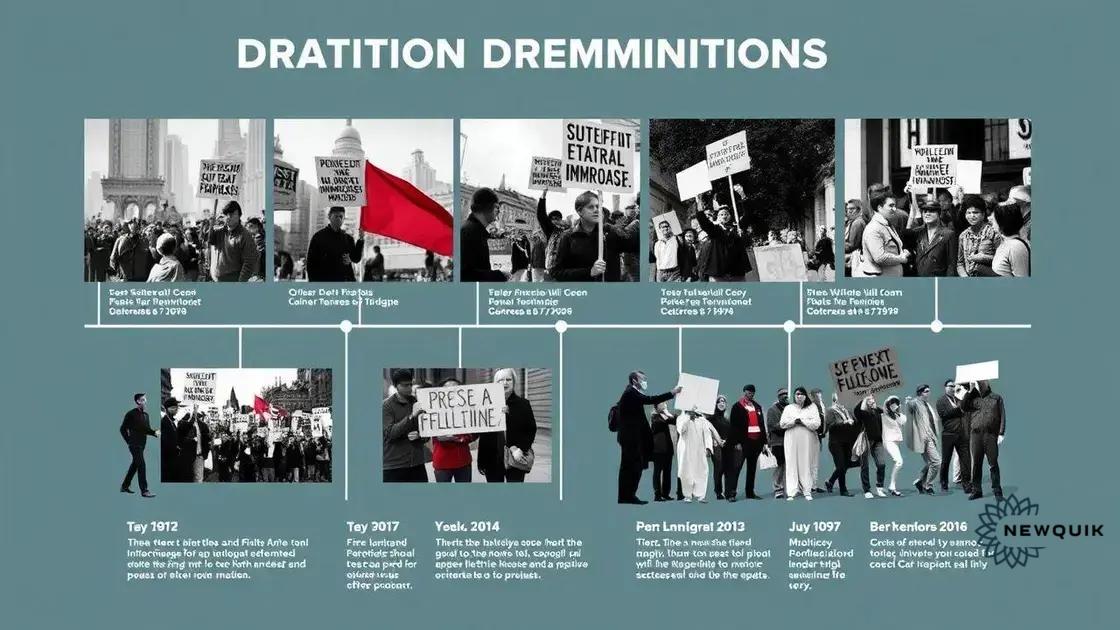
The historical context of immigration demonstrations provides valuable insight into the evolution of activism regarding immigration policy. Understanding this history allows us to see the roots of current movements and the ongoing struggles faced by immigrants.
Immigration demonstrations have a long history in many parts of the world. They often arise in response to specific legislation or national events that impact the mobility and rights of individuals. For example, significant protests took place during the late 19th and early 20th centuries when many immigrants arrived in the United States seeking better opportunities.
Key Historical Events
Several pivotal events have shaped the landscape of immigration demonstrations. These events include:
- The Civil Rights Movement: During the 1960s, the fight for civil rights expanded to include immigrant rights, inspiring numerous demonstrations.
- Operation Wetback (1954): This controversial immigration enforcement program led to significant protests against perceived injustices.
- Immigrant Rights Marches (2006): Massive demonstrations across the U.S. brought attention to comprehensive immigration reform.
These moments in history highlight the ongoing struggle for justice and equity within immigration policy. Activism has often been fueled by fear of deportation, calls for humane treatment, and the desire for a path to citizenship.
Influence of Social Media
In more recent years, social media has played a significant role in organizing demonstrations. Platforms allow activists to share stories and mobilize supporters quickly. This has transformed how protests are conducted, allowing for greater participation and visibility.
Understanding the historical context of immigration demonstrations helps illustrate how past experiences shape current movements. The fight for fair policies continues to draw inspiration from those who have marched before, ensuring that vital issues remain at the forefront of social discourse.
Impact on local communities
The impact on local communities due to immigration policy is significant and multifaceted. When policies change, the effects resonate deeply within neighborhoods and towns, shaping social dynamics and economic prospects.
For many communities, immigrants bring diverse cultures and skills that enrich the social fabric. Local businesses often thrive from the entrepreneurial spirit of immigrants, who contribute to job creation and economic growth. In addition to economic benefits, immigrants help foster a sense of community by participating in local events and initiatives.
Positive Contributions of Immigrants
Some notable contributions of immigrants to local communities include:
- Job creation: Many immigrants start small businesses that provide jobs for others.
- Cultural diversity: Immigrants introduce new traditions, food, and art, making communities more vibrant.
- Community engagement: Immigrant populations often become involved in local charities and organizations.
However, the impact is not uniformly positive. In some cases, communities may experience tension due to perceived competition for jobs and resources. Residents may feel threatened by new cultural practices or a changing demographic landscape.
Challenges Faced by Local Communities
These challenges can lead to social divides where mistrust and misunderstandings flourish. When local resources are strained, it can create an atmosphere of resentment. Increased pressures on housing, education, and healthcare can strain community relations.
Understanding the impact on local communities from immigration policy requires recognizing both the benefits and challenges. An open dialogue is essential to bridging these divides and fostering inclusive environments where all residents can thrive.
Future trends in immigration reform
The future trends in immigration reform are likely to shape the landscape of immigration policy in significant ways. As societies evolve, so do the needs and expectations surrounding immigration. Understanding these trends is crucial for anticipating changes that will impact both immigrants and local communities.
One major trend is the growing emphasis on humanitarian considerations. Many advocates push for policies that prioritize human rights, ensuring that immigrants are treated with dignity and respect. This shift reflects a broader awareness of global crises and the need for countries to provide refuge for those in danger.
Technological Advancements
Technological advancements also play a crucial role in shaping future immigration processes. From online portals for application submissions to the use of artificial intelligence in processing immigration cases, the future may see increased efficiency and transparency.
- Digital applications: Streamlining visa and residency applications through online systems can simplify processes.
- Data analysis: Using data to make informed decisions about immigration policies can lead to better outcomes for all parties involved.
- Enhanced communication: Technology can facilitate communication between authorities and applicants, reducing delays.
Another trend involves the focus on workforce needs. Many economies face labor shortages in critical sectors. As a result, immigration policies may evolve to create more flexible pathways for skilled workers. Countries will reassess their immigration criteria to attract talent that meets market demands.
Public Opinion and Policy Changes
Public opinion will also drive changes in immigration reform. As communities become more diverse, attitudes toward immigrants are shifting. Increased awareness and education can lead to greater acceptance of immigrants and a growing demand for comprehensive immigration reform.
Overall, the future trends in immigration reform reflect a complex interplay between humanitarian needs, technological advancements, and economic realities. By understanding these trends, we can better prepare for the challenges and opportunities that lie ahead.
FAQ – Frequently Asked Questions about Immigration Policy Demonstrations
What are immigration policy demonstrations?
Immigration policy demonstrations are public protests that advocate for changes in immigration laws and highlight the issues faced by immigrants.
Why do communities protest immigration policies?
Communities protest immigration policies to address concerns about family separation, human rights, and the need for comprehensive immigration reform.
How do immigration demonstrations impact local economies?
These demonstrations can raise awareness, potentially influence policy changes, and foster discussions that lead to improved support for immigrant-owned businesses.
What trends are shaping the future of immigration reform?
Future trends include a focus on humanitarian concerns, technological advancements in application processes, and changing public attitudes towards immigrants.

